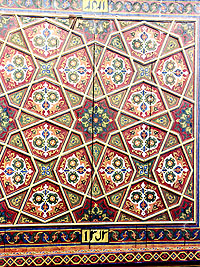 |
|
Uzbekistan - Milestones of History |
|||
|
Thus, early agriculture, based on both natural and artificial irrigation, on the territory of Uzbekistan is thought to have seen its emergence and rise during the first quarter of 2000 B.C. The size and nature of settlements, separate burial complexes, and numerous remains of ceramic tools bear witness to a period of social and occupational division of society, and sharp labor distribution. In its turn, it led to the emergence and further development of urbanized cultures. The first half of 1000 B.C. is a period of further development of ancient society, with class structure and early states arriving on the scene. Also, this is period of discovery of iron, which played a significant role in the entire process of human development. Thus, since those times up to now, iron has always been a basic material tool for humanity. The discovery of iron and other technical improvements served as a basis for the rise of labor productivity in different spheres, and, especially, in agriculture. The areas under arable lands increased, the system of irrigation canals and barrage structures improved (e.g. canal and dam discovered in Bandikhon oasis), handicraft with blacksmiths and arms works, in particular, were further improved at that time. The early practice of exchanges came on the scene. In the middle of 1000 B.C. metallic coins became widespread. The remains of the early Stone Age on the territory of Uzbekistan date back to eight to six centuries B.C. in the ancient provinces such as Bactria , Khorezm, Shosh, and Ferghana Valley. Large centers of the early Stone Age are also known. They are Bandikhon, Kuchuktepa, Talashkan, Kyzyltepa, Chirik-rabat, and others with well-fortified settlements. The remains of ancient agriculture were discovered in oases in Kashkadarya, Tashkent, Bukhara, and Samarkand provinces. The end of 2000 and beginning of 1000 B.C. is characterized as the downfall of primitive society, and rise of large territorial units, which became the prototypes of the formation of the first states. Ancient states. Thus, in early 1000 B.C. ancient territorial and tribal units emerged on the territory of Uzbekistan. The convergence of the social-political interests becomes a peculiar feature of the ancient cultural regions of the area, let alone climatic borders and forms of existence. Predicated on the three basic factors - geographic, form of existence (otherwise can be termed as "economic"), and social - ancient state formations came on the scene on the territory of Uzbekistan. In particular, Big Khorezm was a big and powerful kingdom with a developed agriculture and state irrigation system. The settlers grew wheat, barley, and rice. During the second half of 1000 B.C. the ancient regions of Bactria , Khorezm, and Sogdiana saw the invasion on the part of the Achaemenid tsars, and were further annexed to their huge empire as eastern provinces. The Bactrian lands, according to ancient sources and "History" by Herodotus, occupied a special place in the Achaemenid Kingdom. The Bactrian troops are reported to have participated in vital campaigns led by Achaemenid tsars as the bravest and best trained. Bactria was also one of the richest provinces that paid levies with gold and precious stones. The struggle of eastern provinces to obtain political sovereignty gained more momentum given their prospering economies at that time. In this regard, Bactria stood at the forefront of those events. Agriculture based on irrigation with use of water-dams and large reservoirs provided the basis for the ancient Bactrian economy. During that period, town planning, fortification, architecture and various handicrafts also developed. Trade was expanded towards not only neighboring provinces, but also towards contiguous states. The first caravan roads were laid, which later would become the main pathways for the Great Silk Road. |

